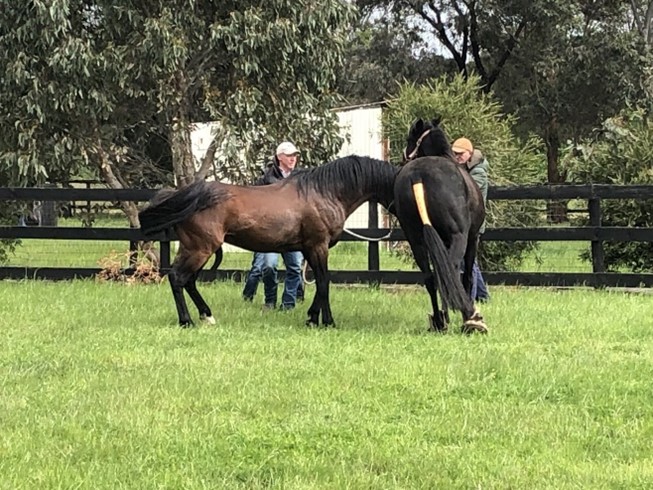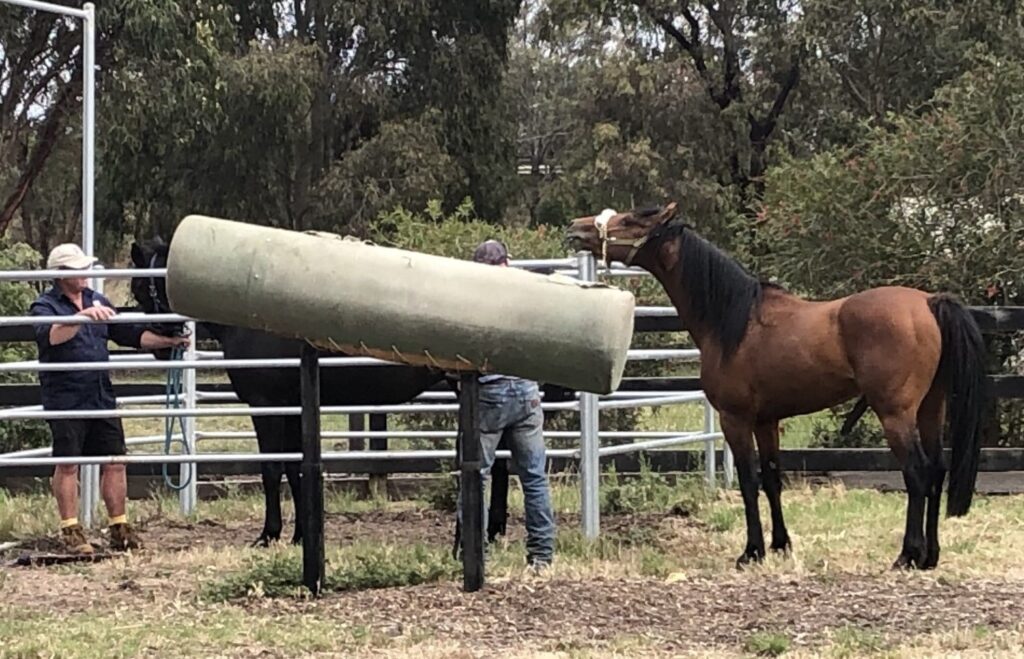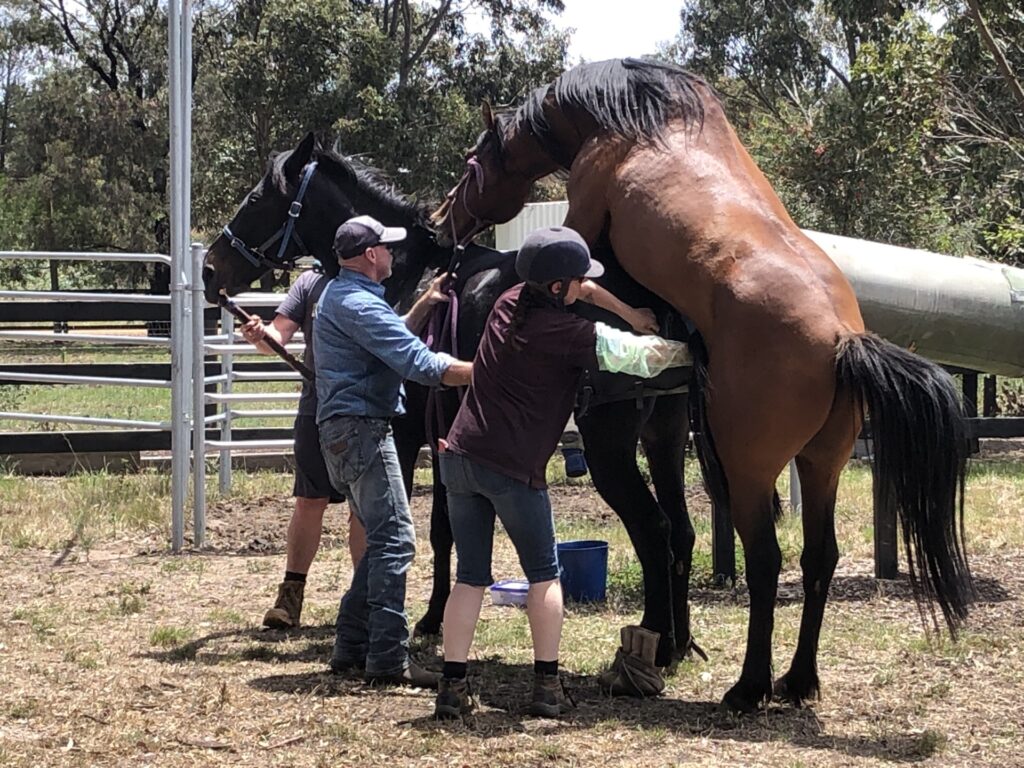Hints for Standing a Stallion at Stud

© Janet Lane. All rights reserved. Image: stallion with teaser mare.
Just a little guide, as requested by a few breeders, which covers artificial insemination, hand-serving, and paddock serving. Nothing herein is a substitute for legal advice.
People’s methods vary too, this is only a guide from a rank amateur who has run her own Waler stallion and worked with hand-serving breeding seasons on a Thoroughbred and an Arab breeding stud, plus had experience with AI in cattle.
Hints for those standing a stallion at stud
AI. Semen is collected, chilled or frozen and delivered to the mare. Collection is the same as hand-serving in essence. The stallion is taken to an equine hospital (vet) for collection, this way the stallion is legally identified as the one on its papers if registered, otherwise is accurately described, and the semen quickly and safely frozen. It may also be collected on farm, and transferred to a vet ASAP.
The containers for collection and distribution can be rented. The key is making sure the receptor mare for the AI is at the right part of her cycle; an ultrasound by a vet, standard procedure, will tell if she’s ovulating. Thoroughbred studbooks and some other breeds will not register foals that are the result of AI. AI need be no more expensive than a live serve, all methods have their costs.


Images: Stallion being teased for collection using dummy, Stallion collection using teaser mare
Hand-serving is when stallion and mare are held on lead-ropes by people while they do the deed. First thing is to be sure the visiting mare has all her immunisations etc done – you’ll need a quarantine area if not, so you can arrange those yourself before she is bred. She will need to be tested for CEM (contagious equine metritis) if she’s been bred before, especially if she missed. Some people leave tests and immunisations up to the stallion owner, and pay the costs. Only do this if you have a suitable quarantine area. You may prefer to stipulate tests are done before she arrives.
Before being bred the stallion meets the mare over a teasing fence – solid so neither can hurt themselves if they strike. Usually of solid wood or old tyres, or a strong stable door. Lead the mare to the barrier. A stallion lifts his head and curls his lips up as he uses his sense of smell to see if she’s in season. If the mare is receptive, it’s seen by her ‘winking’ the vulva, squatting, urinating, tail up, and often squealing at him. Breeding can go ahead. If she’s not showing signs, take her away. These days it’s standard to get a vet out to ultrasound the mare to be sure she’s ovulating. That way you are sure she is ready, or not. Mare owners sometimes do this at home then bring the mare, giving you a day’s notice.
A flat clean place to serve the mare, such as a well fenced yard. A stable breezeway is good as there’s the convenience of nearby stalls. If she’s ready and you’re by yourself, tie the mare to a hitching rail nearby. A few people hobble the back feet in case of kicking. Most don’t as she needs to support herself during serving. Her tail can be tied together with some rubber bands.
Catch the stallion, put his stallion bit on and lead him up to the mare. Lead him firmly, take care. You are in charge. If she starts kicking and is stressed, take him away immediately and return him to his enclosure. Take care as he’ll be excited. This is why you must do teasing – it’s dangerous to get a stallion out for nothing around a mare on season.
A mare cycles for 21 days, the first 4 to 5 days are when she’s ‘in heat’ as she’s ovulating. The next 16 days or so, she is not fertile as her cycle finishes. However, mares like to break the rules so this is merely a guide, some may go another day or three ovulating. 10 to 16 days after the end of her cycle she’ll begin again, through spring and summer. They’re most fertile in early spring – September.
If you have someone hold the mare while serving it makes the job easier. It happens quickly. The stallion will serve the mare, then you return him to his paddock/ yard/ stable, and her into hers.
While serving, a good stallion may hang on by grasping the mare’s mane in his teeth but should never savage her. That sort of stallion is best gelded.
If the stallion is new to the job he may miss the mare and fire a blank into the air. You need the stallion to wait 6 to 8 hours before serving the mare again. Mares are usually served twice, often the next day, but it can happen on the same day if people are waiting with a float to take her home.
Paddock serving. You need a roomy paddock, as stallions get territorial about a little area. A stallion needs room to court a mare, which takes space, as he works out wide. She needs room to get away from him and feel safe during the courting. Legally by most Australian state rules, you must keep a horse in an area over 800 square metres anyway.
You need to know your stallion is a gentle fellow that will court a mare whether she’s in season or not. It’s best if he learns to manage his herd with a mare of your own. If the visiting mare isn’t in season, don’t worry, nature will take its course. If she is, they’ll form a herd more easily and quickly. It’s best if the mare remains some time to be sure she cycles. Sometimes a mare never takes to a stallion, there’s nothing you can do about that. However mostly they settle and live happily together. It is a natural way of serving a mare, healthier for both horses as it keeps their instincts and behaviour. A good paddock stallion is something to be proud of, it shows his good nature more than anything.
If you happen to see the deed, you have a date to predict foaling, otherwise it’s by guess. Most good paddock stallions like to keep private business private. Most people use a vet for ultrasound to be sure when the mare is ovulating, before putting her with the stallion. If she’s missed her heat time there may be up to 6 or 7 weeks until she’s ready again. He can run with more than one mare if there is room.
Financials and legalities. A service is done by contract now, a deposit paid to book the stallion and the remainder paid after the service. If people don’t turn up for a service the deposit is kept. All terms to be made clear on the contract. If people can’t afford a service, they also can’t afford a vet – don’t fall for sob stories for freebies – they always end in disaster.
Typical contract – only a sample – have your own made by a lawyer for your state law requirements http://equine2.com/static/onsitebreedingagreement.pdf
It’s best to offer Live Foal Guarantee (LFG). That means if the mare misses getting in foal, or bears a foal but it dies in the first week, you’ll give the owner a free return service or refund. Make it clear it is either a free service, or refund of the fee, or owner’s choice – it must be clear what your offer is. Some owners use the free service to bring a different mare, fine, as long as she fulfils your requirements for vet checks, behaviour, etc.
You can be sued if you are at fault, if the mare is injured or killed, the people with her while on your property, their property damaged etc. By having good procedures and safe surroundings, a good contract, things will go smoothly. Public liability insurance is wise if you don’t already have it; and any other insurance your lawyer suggests and your wallet runs to.
Biosecurity for farms has just undergone big legislative changes. Horses too must comply – brand or microchip, PIC (property identification code), immunisation/s declarations, are standard now for horses going to shows, through tick area, to different properties. Check what biosecurity needs are for your area and state, your farm, and where the mare is coming from.
Stud Prefix. Check with your breed organisation. Usually you can’t use one already in use. You can’t use another person’s property name without their permission. You can’t put your prefix on a horse you did not breed. If you own a mare when she foals, you can put your prefix on the foal even if you only bought her the day before foaling. The owner of the mare puts their prefix on a foal, not the stallion owner if that is a different person.
There is usually a limit of the number of letters to a total horse name for registration. Brand names, derogatory terms etc not permitted. Most breed organisations register stud prefixes for life to save it running out of registration and being taken by another. If not a member of any organisation, you may still have a prefix but are at risk of an unscrupulous person putting theirs on the horse to register it, if sold on. Make it part of a sale contract the horse’s name is not to be changed. Paddock names can be anything. The name after the prefix may be anything, same names are occur. With Walers, Trooper and Poppy etc occur over and over. They’re told apart by prefix. Originals (foundation) should not have a prefix. Most of these rules were knowingly and unknowingly broken in the early days of getting Walers by those who didn’t know about running a stud, which is a shame; there is no excuse to keep doing it, studbook keepers should refuse wrongfully prefixed horses.
A bit of bother and cost at the start of the season but your stud breeding contract should do for years, unless there’s a law change. A stud is a responsibility and a business. The main thing is to enjoy your horse, enjoy meeting mares and their owners and look forward to foals. It’s worth it. Good luck.